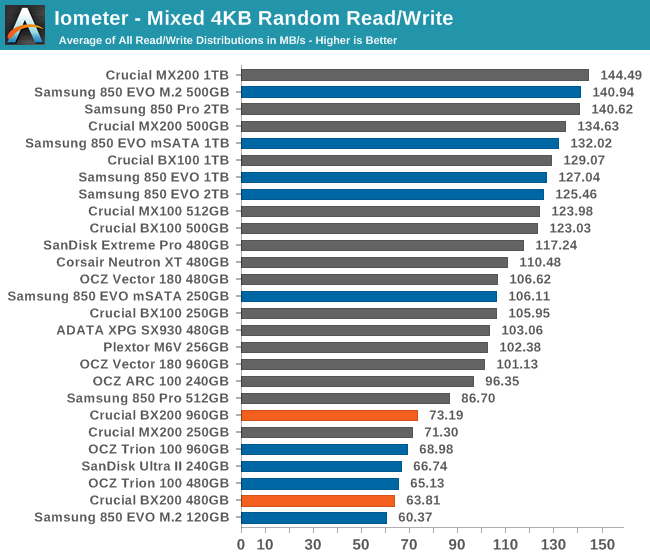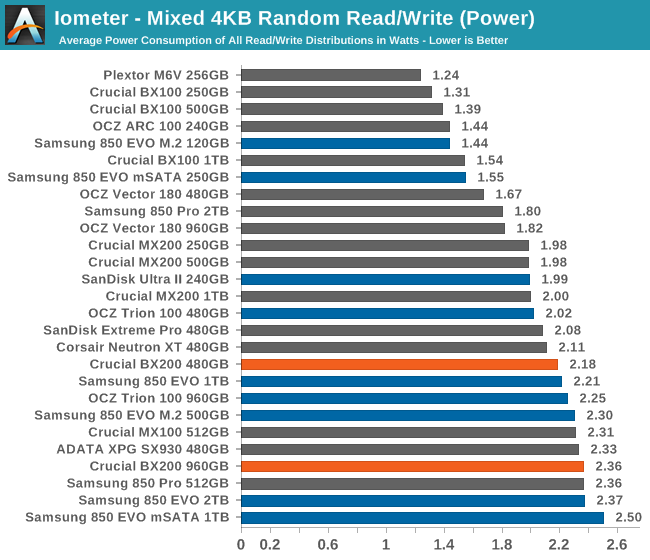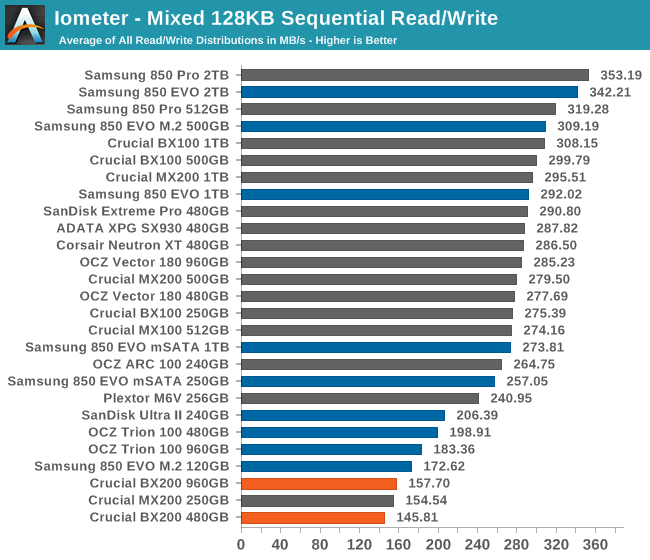The Crucial BX200 (480GB & 960GB) SSD Review: Crucial's First TLC NAND SSD
by Billy Tallis on November 3, 2015 9:00 AM ESTMixed Random Read/Write Performance
Most real-world use consists of a mix of reads and writes, and interleaving the two often poses a particular challenge to drive controllers. This mixed random access test is conducted across a 16GB span of the drive, with a queue depth of 3.

The BX200's reasonable read speeds are apparently able to compensate for the write performance enough to keep at least the 960GB BX200 out of last place for the mixed random test, but the 480GB only manages to surpass a 120GB drive.

The power draw is even more mainstream than the performance, because despite being inefficient the BX200 isn't unreasonably power hungry in an absolute sense.
 |
|||||||||
| Default | |||||||||
Slow and steady doesn't win the race here. Most drives gain speed near the end of the test for the write-heavy portions, but the BX200 gains no performance as the power consumption climbs. It doesn't have the slight bathtub curve shape in the middle the way the Trion 100 does, which is how it keeps pace even without the boost at the end.
Mixed Sequential Read/Write Performance
At either end of this test, when the workload is heavily skewed toward either reads or writes, most drives perform well. In between, performance typically suffers greatly, and that's where the winners and losers of this test are usually determined. Anything that's duplicating or transforming a large amount of data on the drive will produce I/O patterns similar to this test. Creating a System Restore snapshot, backing up files to a different location on the same drive, and file compression can all produce interleaved reads and writes of large blocks of data, though not necessarily fast enough to be limited by the drive's performance. Heavy multitasking can add up to a mixed workload.

With average read speeds and poor write speeds, the BX200 is in last place for the overall average, since the competition didn't have any acute weaknesses.

Average power consumption is once again high, and the 960GB is a particular outlier.
 |
|||||||||
| Default | |||||||||
The graph of performance as more writes come into the mix shows just how quickly things get bad. There's a big jump in power consumption once writes are more common than reads, and the drive is almost as overwhelmed at 40/60 as it is for the pure writes.










85 Comments
View All Comments
paulgj - Monday, November 9, 2015 - link
I just ordered a couple more BX100's 250GBdoggface - Tuesday, November 3, 2015 - link
The MX100 was just brilliant, an easy recommendation.The BX100 has been my go to value SSD, that l I recommended to many friends. The bx200 is garbage which costs more? And is about as bad as a HDD. What the hell crucial. What the hell.Luke212 - Tuesday, November 3, 2015 - link
BX100 and MX100 were great.... how can they go backward so badly?JDG1980 - Tuesday, November 3, 2015 - link
It's looking more and more as though TLC is a big flop. It doesn't seem to provide substantial price savings, and it comes at a considerable cost in performance, durability, and reliability.For a TLC drive to be worth it, it would need to be 1/2 to 1/4 the cost per gigabyte of a MLC solution on the largest drives. It then might be acceptable for people who want moderately priced bulk storage that's cheaper than standard SSDs. But that's not close to being the case now, and it may never be.
CiccioB - Wednesday, November 4, 2015 - link
Yeah, I still wonder if TLC is really reliable as producers advertise them.Samsung needed a "hack" to their 840 TLC series to solve data retention problems reducing life time.
We do not know if others have done the same without (obviously) telling publicly. And if 850 series has it under the hood.
I would go to MLC drives for few $ more. I feel them as more reliable and durable. And "feeling" is an important thing for me, as I put my data on them and saving few bucks may not really be an advantage when a TLC drive lives less then a MLC one.
For performance, I bet anyone to be able to discern differences in real life form an SSD to another. This are "synthetic" tests, where source of data is faster than SSD speed (RAM). For whatever real usage, anything comes from sources that are slower (HDD, network, optical disks). Load times into RAM is limited, as you don't usually load GB and GB into it but during a benchmark.
What it really matters is reliability, durability and price. TLC fails to make me comfortable with the first two criteria. Which, for me, are the most important ones.
CiccioB - Wednesday, November 4, 2015 - link
"This are "synthetic" tests"These are synthetic tests.
Edit button, please!
extide - Thursday, November 5, 2015 - link
Yeah it seems like you really need to go to 3D NAND to get decent TLC -- the 850 EVO's have so far been pretty much great. That significantly larger feature size really helps the TLC out.Beaver M. - Wednesday, November 4, 2015 - link
No wonder I have been skipping reviews of new SATA SSDs for a few years now. Nothing can touch the Samsung ones, and thats sad.ghanz - Wednesday, November 4, 2015 - link
Review request: Please do a review of Sandisk Plus, their current lowest tier SSDs available in 120gb and 240gb capacities.Will be interesting to see how those compares to the BX100 and BX200 in similar capacities.
Mugur - Wednesday, November 4, 2015 - link
I must buy another BX100 until the stocks will dry...